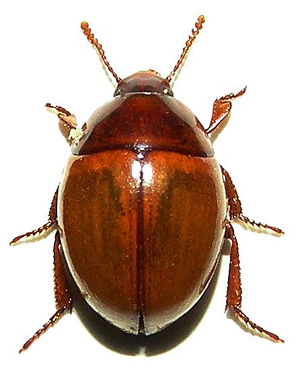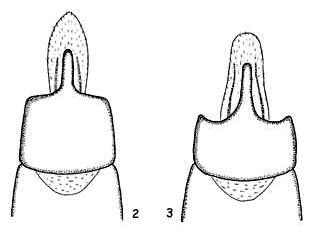Halammobia bulla Liberto & Leo, 2006, nový druh pro faunu Černé Hory (Coleoptera: Tenebrionidae: Diaperinae)
1Department of Forest Protection and Entomology, Faculty of Forestry and Wood Sciences,
Czech University of Life Sciences, Kamýcká 1176, CZ-165 21, Praha 6 - Suchdol, Czech Republic
e-mail: jh.dermestidae@volny.cz
2Via P. Tola, 21 - 09128 Cagliari, Italy
3Gorazdova 19, CZ-120 00 Praha 2, Czech Republic
4Za lesem 246, CZ-277 11 Neratovice, Czech Republic
5Vinohrady 97, CZ-27742 Obříství, Czech Republic
Abstract. The psammo-halophilous species Halammobia bulla Liberto & Leo, 2006 is reported for the first time in Montenegro. The distribution and the differential characters of the two species of genus Halammobia are discussed.
Key words: faunistics, new record, Coleoptera, Tenebrionidae, Diaperinae, Halammobia bulla, Montenegro
Introduction
Knowledge about the coleoptera fauna of Montenegro is still very incomplete, despite some recent works reporting new findings (Kovács et al. 2011, Németh et al. 2014, Kejval 2017, etc.); further increase in new findings is likely in the future. In this work Halammobia bulla Liberto & Leo, 2006 (Tenebrionidae) is registered for the first time in Montenegro: numerous specimens were collected by Czech entomologists in the south of the country, in two beaches in the surroundings of Ulcinj. The genus Halammobia Semenov, 1901, belonging to subfamily Diaperinae and tribe Phaleriini (Löbl et al. 2008), includes only two psammo-halophiles species distributed in Mediterranean Subregion of Palaearctic (Liberto & Leo 2006).
Material
Mentioned material are deposited in the following collections:
ASPC Adam Šíma, private collection, Prague, Czech Republic;
JHAC Jiří Háva, Private Entomological Laboratory & Collection, Únětice u Prahy, Prague west, Czech
Republic;
PJPC Petr Jansa, private collection, Obříství, Czech Republic;
PLPC Piero Leo, private collection, Cagliari, Italy;
VHPC Václav Hanzlík, private collection, Neratovice, Czech Republic.
Results
Halammobia bulla Liberto & Leo, 2006
(Figs. 1-2)
Material examined: Montenegro, Ulcinj, Velika beach, 41°54'19.45"N, 19°15'32.28"E, 5.v.2014, A. Šíma leg., 6 spec., (ASPC); Montenegro, Ulcinj, Ada Bojana beach, 41°51'49.05"N, 19°20'28.95"E, 4.v.2014, A. Šíma leg., 20 spec., (18 ASPC, 2 PLPC); Montenegro, Ulcinj, Ada Bojana beach, 19.v.2014, P. Jansa [or V. Hanzlík] leg., 27 spec., (2 JHAC, 9 VHPC, 16 PJPC).
Bionomy. The specimens were collected in dunes on a sandy beach under the remains of plants.
Distribution. This species was known from some localities of western Peloponnese, in the southern Greece (Liberto & Leo 2006); also the quotation of Whitehead (1997) for Zakynthos (Ionian Islands), as Halammobia pellucida, is certainly to be referred to H. bulla. The species is new for Montenegro and its range of distribution seems considerably expanded (450 km northwards). The new finds in Montenegro suggest the possible presence of the species even in the north-western part of Greece and in Albania.
Diagnosis. The genus Halammobia includes only the species discussed here (H. bulla) and the similar species Halammobia pellucida (Herbst, 1799). Halammobia bulla is characterized by the following features: body elliptic, dorsally very convex, elytra evenly sloping toward apex in lateral view, while are tumid and abruptly sloping in H. pellucida; sides of pronotum more convergent forward and apical part of elytra more narrowed than in H. pellucida; elytral striae faint, effacing, only the first one running along the suture and nearly reaching the apex, while in H. pellucida at least striae 1-3 are rather shallow but well developed and reach the apex; intervals among striae absolutely flattened, smooth, bearing no minute transverse wrinkles like in H. pellucida; further differential features are shown by the shape of aedeagus (Figs. 2-3).

Fig. 1. Habitus, dorsal aspect of Halammobia bulla.

Figs. 2-3. Male genitalia: 2 – Halammobia bulla; 3 – H. pellucida.

Fig. 4. Map of distribution of Halammobia bulla.
Distribution. This species is mentioned only from France and Italy in Catalogue of Palaearctic Coleoptera (Löbl et al. 2008), but it is also well known from the Mediterranean coast of Spain (Español 1969) and Morocco (Liberto & Leo 2006).
References
Español F. 1969: Los Phaleriinae de la Peninsula Ibérica e Islas Baleares (Col. Tenebrionidae). Graellsia 24: 87-94.
Kejval Z. 2017: New species, synonymy and records of Mecynotarsus (Coleoptera: Anthicidae). Klapalekiana 53: 299-322.
Kovács T., Merkl O., Németh T. & PEŠIZ V. M. 2011: True bugs and beetles new to Montenegro and Bulgaria (Insecta: Heteroptera, Coleoptera). Folia Historica Naturalia Musei Matraensis 35: 39-42.
Liberto A. & Leo P. 2006: Una nuova Halammobia del Peloponneso e nuovi dati faunistici sui Tenebrionidi della Grecia (Coleoptera, Tenebrionidae). Fragmenta Entomologica, Roma 38(2): 251-277.
Löbl I., Merkl O., Ando K., Bouchard P., Lillig M., Masumoto K. & Schawaller W. 2008: Tenebrionidae. In: Löbl I. & Smetana A. (eds.): Catalogue of Palaearctic Coleoptera. Volume 5. Tenebrionoidea. Stenstrup: Apollo Books, 670 pp.
Németh T., Dušánek V., MertlIk J. & Kundrata R. 2014: New distributional data on Elateroidea (Coleoptera: Elateridae, Eucnemidae and Omalisidae) for Albania, Montenegro and Macedonia. Elateridarium 8: 112-117.
Whitehead P. F. 1997: The Coleoptera of Zakynthos, Greece. In: Studies in Quaternary Entomology – An Inordinate Fondness for Insects. Quaternary Proceedings 5: 277-291.

